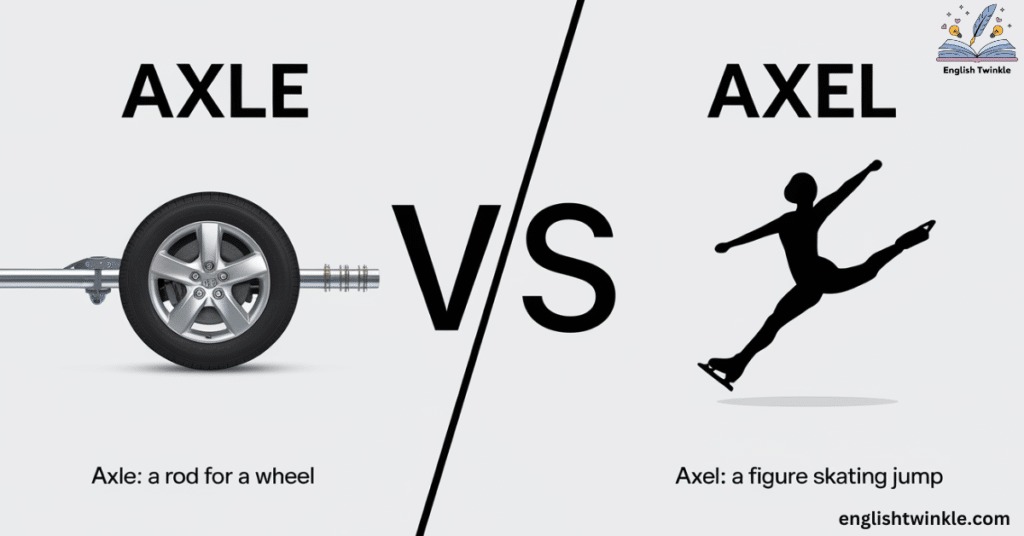In our journey through language and mechanics, we often encounter words that sound alike but have vastly different meanings. “Axle” and “Axel” are prime examples of this linguistic phenomenon. This comprehensive guide will take you on a deep dive into the worlds of axles and Axels, exploring their definitions, origins, and significant roles in various fields. Buckle up as we embark on this enlightening ride!
The Wheel Deal: Introduction to Axle and Axel
At first glance, “axle” and “Axel” might seem interchangeable, but they couldn’t be more different. One is a crucial mechanical component, while the other is a name with rich cultural significance. Let’s break down these terms and explore their unique identities.
Axle: The Unsung Hero of Transportation
An axle is a central shaft for a rotating wheel or gear. It’s the backbone of many mechanical systems, playing a vital role in vehicles, machinery, and even some unexpected places. Here’s a quick rundown of axle types:
- Dead axle: Doesn’t rotate, supports weight
- Live axle: Rotates with the wheels
- Floating axle: Supports vehicle weight and drives wheels
The axle meaning extends beyond just a rod. It’s a critical component that has shaped transportation history, from ancient chariots to modern electric vehicles.
Axle: Word Meaning, Examples, and Synonyms
| Aspect | Details |
|---|---|
| Definition | A rod or spindle (either fixed or rotating) passing through the center of a wheel or group of wheels |
| Examples | Car axle, bicycle axle, wind turbine axle |
| Synonyms | Shaft, spindle, arbor, mandrel |
| Related Terms | Axle shaft, drive shaft, half-shaft |
Axel: More Than Just a Name
Axel, on the other hand, is primarily a name of Scandinavian origin. It’s gained popularity worldwide and has left its mark in various cultural spheres. The name Axel has several notable associations:
- Figure skating Axel: A challenging jump named after Axel Paulsen
- Literature and film: Used as a character name in various works
- Historical figures: Several notable people throughout history have borne this name
Axel: Word Meaning, Examples, and Synonyms
| Aspect | Details |
|---|---|
| Definition | A male given name of Scandinavian origin |
| Examples | Axel Paulsen (figure skater), Axel Rose (musician) |
| Related Terms | Absalom, Aksel, Axl |
| Cultural References | Figure skating jump, characters in literature and film |
The Great Divide: Axle vs. Axel
To avoid confusion, let’s break down the key differences:
| Aspect | Axle | Axel |
|---|---|---|
| Pronunciation | AK-suhl | AK-suhl |
| Primary meaning | Mechanical component | Personal name |
| Origin | Old Norse “öxull” | Old Norse “Ásketill” |
| Common usage | Engineering, transportation | Personal names, figure skating |
| Mnemonic Magic: Remembering the Difference Here’s a handy trick to keep these terms straight: “The axle in my car goes round and round, but Axel the skater spins round and round.” |
Axles in Action: Beyond the Basics
The axle definition might seem simple, but its applications are vast and varied. Let’s explore some key areas where axles play a crucial role:
Automotive Applications
In the world of vehicles, axles are indispensable. From car axles to truck axles, these components bear the weight of the vehicle and transfer power from the engine to the wheels. Here are some key types:
- Front axle: Supports front wheels, absorbs shocks
- Rear axle: Typically drives the vehicle in rear-wheel-drive cars
- Stub axle: Connects wheels to the front axle in some designs
Case Study: The Evolution of Truck Axles
Truck axles have come a long way since the early days of automotive engineering. In the 1920s, most trucks used solid axles, which were sturdy but provided a rough ride. The introduction of independent front suspensions in the 1930s marked a significant improvement in ride quality and handling.
Today, modern truck axles are marvels of engineering. For instance, the Dana Spicer AdvanTEK 40 tandem axle, introduced in 2013, offers a 400-pound weight reduction compared to its predecessors. This not only improves fuel efficiency but also increases payload capacity.
“The evolution of truck axles is a testament to human ingenuity. We’ve gone from simple steel bars to complex systems that optimise weight, strength, and efficiency.” – Dr. Sarah Wheelwright, Automotive Engineering Expert |
Beyond Cars: Diverse Axle Applications

Axles aren’t limited to automobiles. They’re found in a wide range of applications:
- Bicycle axles: Connect pedals to wheels in our two-wheeled friends
- Industrial machinery: Power conveyors, elevators, and more
- Wind turbines: Transfer wind energy into electrical power
- Robotics: Enable precise movements in automated systems
Cutting-Edge Axle Technology
Innovation never stops, and axle technology is no exception. Some exciting developments include:
- Smart axles with built-in sensors for real-time monitoring
- Lightweight composite axles for improved fuel efficiency
- Regenerative axle systems in electric vehicles
The Future of Axles: A Glimpse into Tomorrow’s Technology
As we look towards the future, axle technology is poised for some revolutionary changes:
- Integrated Electric Motors: Electric vehicles are driving a trend towards axles with integrated electric motors. This design, known as e-axles, combines the electric motor, gearing, and power electronics into a single, compact unit. Companies like Bosch and ZF are at the forefront of this technology, which promises improved efficiency and packaging.
- Active Suspension Systems: Future axles may incorporate active suspension systems that can adjust in real-time to road conditions. This technology could dramatically improve ride comfort and handling, especially in autonomous vehicles.
- Self-Lubricating Axles: Researchers are working on developing axles with self-lubricating properties. These could significantly reduce maintenance needs and extend the lifespan of axle components.
- Shape Memory Alloys: Some scientists are exploring the use of shape memory alloys in axle design. These materials can “remember” their original shape and return to it when heated, potentially allowing for axles that can self-repair minor damage.
- Nanocomposite Materials: Nanotechnology is opening up new possibilities for axle materials. Nanocomposite axles could offer unprecedented strength-to-weight ratios, further improving vehicle efficiency.
| “The axle of tomorrow won’t just be a passive component. It will be an active, intelligent system that adapts to its environment and communicates with the rest of the vehicle.” – Dr. Emma Gears, Mechanical Engineering Professor |
Axel: From Ice Rinks to Silver Screens

While “axle” dominates the mechanical world, “Axel” has made its mark in cultural spheres, particularly in figure skating.
The Axel Jump: A Figure Skating Legend
The Axel jump, named after Norwegian figure skater Axel Paulsen, is one of the most challenging moves in figure skating. Here’s why it’s so famous:
- It’s the only jump that takes off from a forward outside edge
- Skaters rotate 1.5 times in the air (in a single Axel)
- It’s considered a benchmark of a skater’s skill
Axel Jump Variations
| Jump Type | Rotations | Difficulty Level |
|---|---|---|
| Single Axel | 1.5 | Intermediate |
| Double Axel | 2.5 | Advanced |
| Triple Axel | 3.5 | Expert |
| Quad Axel | 4.5 | Elite (Rarely performed) |
The History of the Axel Jump
The Axel jump has a rich history in the world of figure skating:
- 1882: Axel Paulsen, a Norwegian figure skater and speed skater, performs the first Axel jump at a competition in Vienna.
- 1920s: The Axel becomes a standard element in figure skating routines, but remains a single jump.
- 1948: Dick Button lands the first double Axel in competition at the Winter Olympics in St. Moritz.
- 1978: Vern Taylor of Canada lands the first triple Axel in competition at the World Championships.
- 1988: Midori Ito becomes the first woman to land a triple Axel in competition.
- 2022: Ilia Malinin lands the first quad Axel in competition at the U.S. International Figure Skating Classic.
| “The Axel jump is the Mount Everest of figure skating. It’s not just about strength or technique, but a perfect blend of both.” – Michelle Kwan, Olympic figure skater |
Axel in Popular Culture
Beyond the ice rink, the name Axel has found its way into various cultural products:
- Literature: Featured in fantasy novels and children’s books
- Movies: Often used for dynamic, adventurous characters
- Video games: A popular choice for protagonists
When Worlds Collide: Axle and Axel Mix-ups

Despite their distinct meanings, “axle” and “Axel” often lead to confusion. Here are some real-world examples:
- A car enthusiast forum post titled “Help with my Axel!” (They meant axle)
- A figure skating article discussing “The physics of the axle jump” (Should be Axel)
These mix-ups can lead to amusing situations, but in professional settings, they can cause misunderstandings or even costly mistakes.
The Importance of Precision in Language
While the confusion between “axle” and “Axel” might seem trivial, it highlights a broader issue: the importance of precision in language, especially in technical fields. Here’s why it matters:
- Safety: In engineering and mechanics, using the wrong term could lead to misunderstandings that compromise safety.
- Efficiency: Clear communication saves time and resources in any professional setting.
- Credibility: Using terms correctly enhances your credibility and professionalism.
- Legal Implications: In contracts or technical documents, the wrong term could have legal consequences.
- Cultural Sensitivity: Misusing a name like Axel could be seen as disrespectful in certain contexts.
| “In the world of engineering, precision is everything. That applies to our calculations, our designs, and absolutely to our language.” – Dr. Robert Gearson, Linguistic Engineer |
The Etymology Express: Tracing Origins
Understanding the origins of these words can help cement their differences in our minds.
Axle: A Journey Through Time
The word “axle” has a fascinating linguistic history:
- Old Norse: “öxull”
- Old English: “eaxl”
- Middle English: “axel” (ironically!)
It’s been a part of our language for centuries, evolving alongside the technology it describes.
Axel: A Name with Norse Roots
The name Axel has its own intriguing etymology:
- Derived from Old Norse “Ásketill”
- Meaning: “Father of Peace” or “God’s Cauldron”
- Popularized in Scandinavia and later spread globally
Axle Innovations: Driving the Future
As we look to the future, axles continue to play a crucial role in technological advancements:
Electric Vehicle Axle Designs
Electric vehicles (EVs) are revolutionizing axle design:
- Integrated electric motors in the axle for improved efficiency
- Dual-motor axles for enhanced performance and traction
- Lightweight designs to extend EV range
Case Study: Tesla’s Revolutionary Axle Design
Tesla, a leader in EV technology, has made significant strides in axle design. Their Model S Plaid, introduced in 2021, features a tri-motor axle design that’s a game-changer in the industry:
- Three Independent Motors: Unlike traditional EVs with one or two motors, the Plaid has three – one on the front axle and two on the rear.
- Torque Vectoring: This setup allows for precise control of power delivery to each wheel, enhancing handling and performance.
- Efficiency and Power: The design allows for a mind-boggling 1,020 horsepower while maintaining efficiency.
- Carbon-Sleeved Rotors: Tesla uses carbon-fiber-sleeved rotors in the motors, allowing them to spin at up to 20,000 RPM, far exceeding typical EV motor speeds.
| “Tesla’s tri-motor axle design in the Model S Plaid isn’t just an incremental improvement; it’s a paradigm shift in how we think about EV powertrains.” – Elon Musk, CEO of Tesla |
Aerospace Applications
Even in the sky, axles have their place:
- Landing gear systems in aircraft
- Helicopter rotor systems
- Satellite deployment mechanisms
Robotics and AI: The Role of Axles in Automation

In the world of robotics, axles enable precise movements:
- Articulated robot arms in manufacturing
- Exploration rovers for other planets
- Humanoid robots mimicking human joint movements
The Cultural Impact of Axel
While we’ve explored the technical side of axles, the name Axel has had its own significant cultural impact:
Axel in Literature and Film
The name Axel has been a popular choice for fictional characters, often embodying strength, adventure, or rebellion:
- Jules Verne’s “Journey to the Center of the Earth”: The protagonist, Axel Lidenbrock, embarks on a fantastic subterranean adventure.
- Kingdom Hearts Video Game Series: Axel is a complex and popular character known for his catchphrase, “Got it memorized?”
- Beverly Hills Cop Film Series: Eddie Murphy’s character, Axel Foley, is a quick-witted Detroit cop who finds himself in Beverly Hills.
The Axel Effect in Naming Trends
The popularity of the name Axel has seen interesting trends over the years:
- In the United States, the name Axel entered the top 1000 names in 1989 and has been steadily rising in popularity.
- As of 2020, it ranked 104th in popularity for male names in the U.S.
- The name has seen particular popularity in Scandinavian countries and among parents looking for strong, unique names.
| “Names like Axel carry a certain energy. They’re strong, a bit edgy, and have this cool factor that appeals to many parents.” – Dr. Laura Wattenberg, Name Expert and Author |
Conclusion: Axle-rating Our Understanding
As we’ve seen, “axle” and “Axel” may share similar sounds, but they inhabit very different worlds. From the mechanical marvels that keep our vehicles rolling to the graceful ice skating move that defies gravity, these terms represent the diversity of human innovation and culture.
Understanding the difference between “axle” and “Axel” is more than just a linguistic exercise. It’s a gateway to appreciating the precision of language and the fascinating worlds these words represent. Whether you’re a mechanical axle enthusiast, a figure skating fan, or simply someone who loves to learn, the stories of axle and Axel offer something for everyone.
So next time you hear either of these words, you’ll know exactly which world you’re stepping into – the world of wheels and machines, or the world of names and ice skating glory.
Test Your Knowledge: Axle vs. Axel Quiz
Let’s see how well you’ve grasped the differences between axle and Axel with this quick quiz:
- Which of the following is a mechanical component in vehicles? a) Axel b) Axle c) Both d) Neither
- The Axel jump in figure skating is named after: a) A car part b) A Norwegian skater c) A Greek god d) A type of ice
- Which word has its origins in Old Norse meaning “Father of Peace”? a) Axle b) Axel c) Both d) Neither
- In a car, the axle is responsible for: a) Playing music b) Supporting weight and transferring power c) Cooling the engine d) Inflating tires
- The quad Axel in figure skating involves how many rotations? a) 2.5 b) 3.5 c) 4.5 d) 5.5
Answers: 1-b, 2-b, 3-b, 4-b, 5-c
Whether you’re dealing with vehicle axles or cheering for a skating champion performing an Axel, precision in language and understanding can make all the difference. Keep spinning those linguistic wheels and jumping into new knowledge!

Freck John, linguist and English educator, shares grammar insights and writing tips at English Twinkle, making language concepts accessible to all learners.







